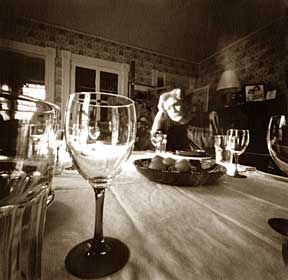|
Perhaps all photographs can be looked at from the different perspectives of what they represent and what they suggest. My recent work with pinhole and modified plastic Holga cameras (a Holga is a modern day version of the classic Diana camera) has been an attempt to capture the mystery that exists in our relationship with the world and others around us. Although I embrace all forms of photographic imagery--I’ve worked for years in color with Nikon cameras--composed images carefully with view cameras--marvel at the latest digital techniques--this body of work marks a return to some of photography’s simplest processes. I process all my own film and prints and even make some of my own cameras. |
 |
|
A pinhole camera has no lens.
An exposure might range from 2 seconds to several hours. Time becomes
a significant element to consider. No longer is the exposure an out-of-sync
with the world 1/125th of a second. The subject must often participate
in the event. The result is often a complete surprise. There is no viewfinder
on the pinhole camera I use. I’m forced to rely on experience,
intuition and be open to the possibilities of chance. Though the equipment is unsophisticated, the results can be quite fantastic. The photographs for me are full of wonder and mystery and new discoveries. The majority of work that
ended up in this show is from my work with Holga cameras. Like many
photographers I was drawn to the novelty of the Holga (plastic toy camera)
and had played with it over the years. In the summer of 1999 I seriously
began to use the Holga as my primary camera. With only one f/stop and
shutter speed there’s nothing to worry about but the image itself.
Since the camera costs less than $20 you can take it apart and modify
it in a number of ways to control exposures and effects if desired. Hundreds of rolls of film
and thousands of negatives later I still marvel at the representation
of the world the Holga gives me. On a recent trip to Ireland, it was
the Holga and not the Nikon that captured images closer to what I felt
about the landscape and my surroundings (or perhaps closer to what my
memories are of those experiences). As a photographer I work
with real elements in the world around me. As I select and edit what
I shoot and what I print the photos become part of a personal world
or vision. In the end though--it’s
really the blend of the real and the unreal that intrigues me and keeps
me trying to discover something about the world around me through photography.
The many ways a photograph can be interpreted--the way a photograph
might stop and make you think about the world and how you perceive it. I’m deeply grateful for the Vermont Council on the Arts Opportunity Grant that I received in 2001 that helped me devote the time and energy necessary to bring this body of work together. Because of limitations of space, the work here represents a small amount of the total work produced with the grant. |
| home | gallery 1 |